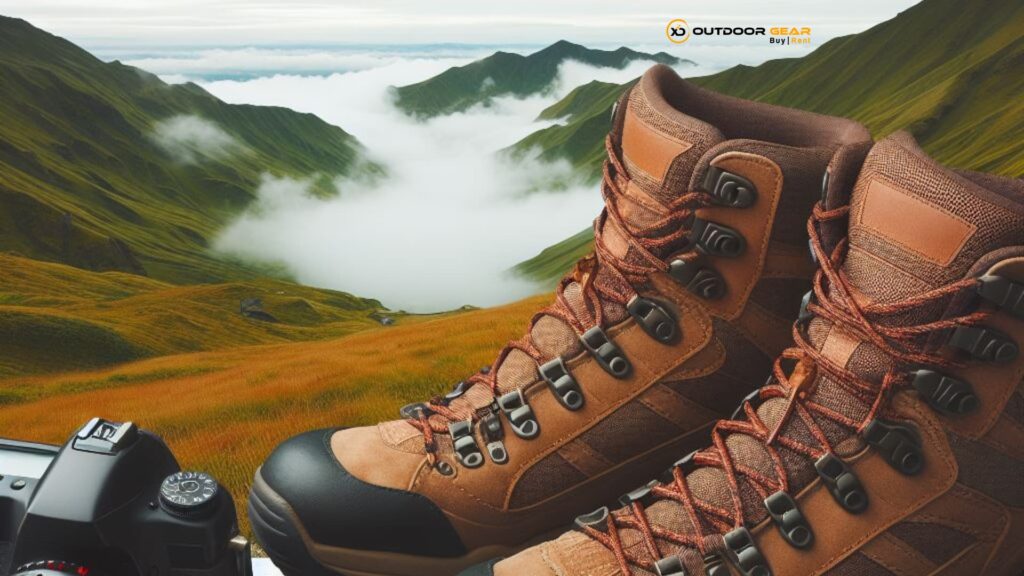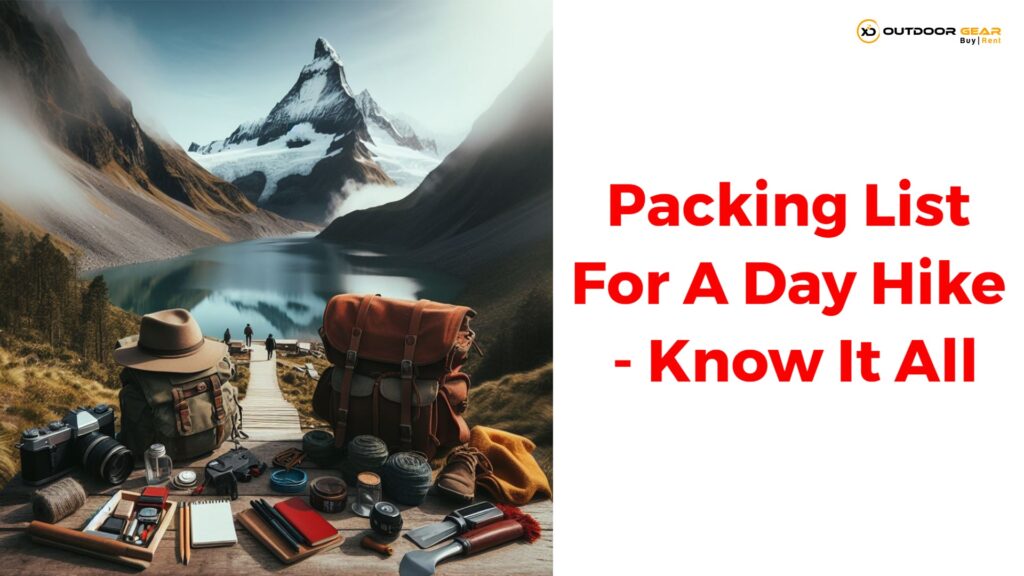Here’s a packing list for a day hike that can be as simple as a stroll on a groomed trail or as demanding as a 15-mile trek through remote wilderness. While a short city park walk may need only sturdy shoes and water, gearing up for a full day in the backcountry requires more careful preparation and packing.
This extensive guide of packing list for a day hike covers optimal gear for safe, comfortable single-day hiking trips spanning every season and terrain type. We’ll offer suggestions on clothing, navigation tools, safety kit components, and footwear without promoting any specific brands, allowing you to shop for options that match your budget and preferences.
Packing List For A Day Hike: The Ultimate Hiking Trip Packing List
| Category | Hiking Gear Items |
|---|---|
| Footwear | Hiking shoes/boots, spare laces, socks |
| Clothing | Baselayers, hiking pants, insulation layer, rain shell |
| Pack | Daypack, hydration reservoir/bladder |
| Navigation | Physical maps, compass, GPS device/app |
| Safety | First aid supplies, fire starter, light sources |
| Nutrition | High calorie snacks, electrolyte supplements |
| Tools | Knife or multi-tool, duct tape, toilet trowel |
| Weather Protection | Sunglasses, sunscreen, hat, insect repellant |
Matching Footwear to the Terrain
Starting from the ground up, appropriate footwear shields feet from rocks, roots, and unstable obstacles twisting delicate ankles or battering toes over endless miles. Materials and traction components equip hiking shoes and boots for everything from mellow forested rambles to ascending rocky ridgelines with 50-pound packs.

➤ Hiking Shoes
Mid-height hiking shoes stabilize feet when carrying light loads over moderately uneven terrain – the daily drivers for most day hikers. If purchasing, look for:
- Supportive cushioned midsoles
- Sticky rubber outsoles
- Protective toe bumpers
- Quick lacing adjustments
- Partial waterproof membranes
Well-fitted hiking shoes provide enough structure for varied topography without the stiffness of heavyweight boots. Focus on models offering breathability, flexibility, and grip rather than ultra-rugged builds best saved for expeditions under full backpacking packs.
➤ Hiking Boots
More extreme cold weather day hikes and off-trail scrambling over uneven ground warrant taller, insulated boots with rigid shanks transferring power to the soles. Key characteristics include:
- Warm insulation layers
- External support frames
- Multi-directional deep traction lugs
- Integrated gaiters preventing debris entry
- Shock absorbing midsoles
The tallest varieties anchor ankles against rolls which could immobilize hikers miles from help. Waterproof leather or woven synthetic fabrics keep feet dry hopping creeks along the way.
More Footwear Considerations
➤ Moisture Wicking Socks – Avoid blisters by wearing properly fitted merino wool or synthetic fabric hiking socks wicking moisture from skin. Consider lightweight liners under bulky cushioned outer socks as well. Replace all each season matching observed wear rates.
➤ Supportive Insoles – Swap flimsy generic insoles boosting shoes and boots with shaped supportive aftermarket versions instead like Superfeet. Replace every 300-500 miles.
➤ Gaiters – Taller gaiters protect shins and vulnerable shoe tops from intruding snow, mud, gravel and water crossing days.
➤ Crampons/Traction Cleats – Temporary strap-on traction chains like Kahtoola MICROSpikes dig into hardened snow or icy trails, ideal for transitional winter conditions when base traction lugs start floating across frozen terrain.
Dialing in Comfort Through Layering
➤ Moisture Wicking Baselayers
Avoid cotton shirts trapping sweat against the skin from the get-go. Synthetic polyester and merino wool wick moisture outward where airflow evaporates dampness for effective cooling. Today’s athletic baselayers feature natural stretch and antimicrobial treatments controlling odors over consecutive long-wear days.
➣ Ideal Baselayer Characteristics:
- Snug athletic cut
- Flatlocked seams
- UPF sun protection factors
- Vented stretch panels
➣ Materials to Seek Out:
- Merino wool
- Polyester
- Nylon
- Spandex/Elastane
➤ Insulated Mid Layers
When resting or weather deteriorates miles from the trail head, mid layers retain core body heat keeping vital organs warm. Differing designs and fills suit everything from high-output aerobic activity to belaying immobile waiting for storms to pass.
Common Options:
- Fleece – Fast-drying fuzzy fleece builds warmth without overwhelming bulk best for hard-charging output.
- Synthetic Insulated – PrimaLoft and similar proprietary fills mimic properties of down insulation using advanced synthetic fibers retaining loft even when damp.
- Down Insulation – Unmatched weight-to-warmth ratios compress down incredibly small but sacrifice insulating capacity when soaked by storms or creek crossings.
- Wind Blocking Fleeces – Deceptively thin but surprisingly warm, soft shell jackets defeat cold penetrating winds stealing precious body heat without fully blocking moisture evaporation from sweating underneath.
➤ Weather Protection Outer Layers
➣ Rain Gear – Waterproof breathable rated rain shells (and pants for colder months) keep pelting precipitation from soaking through on full day exposed hikes. But expect wet from within from trapped exertion sweat if worn constantly minus occasional cooling breaks. Durably constructed 2 to 3-layer fabrics enhance weather protection and ventilating characteristics.
➣ Wind Breakers – Ultra minimalist wind shirts add fast and light barrier blocking abrasive gusts when warmer base and mid layer pieces already wick away moisture. Half length zippers retain packable size for stashing when clear.
➤ Accessory Clothing Layers

➣ Hats – Shield ears, bald spots and necks from harsh UV rays with at least three-inch minimum brim widths. Light colors reflect more radiation. Dark underbrims prevent glare from interfering with sight lines. Some models incorporate fabric flaps protecting the sides of the face and neck as well.
➣ Sunglasses – Guard eyes from blowing trail dust and reflective sunlight off water or snow. Prioritize impact-resistant lenses, and polarized filters reducing glare and spectrum-specific tints highlighting definition with color-neutral visual acuity. Sport varieties wrap widely enhancing coverage and visibility uninhibited by frame edges.
➣ Gloves – Spare fingers direct exposure and abrasion retaining critical dexterity manipulating gear on the move. But full finger coverage becomes necessary for warmth as the mercury plummets. fleeces, soft shells, or even waterproof breathable membranes equip gloves for everything from crisp conditions to deep winter extremes.
Gear Carrying Packs
Daypacks – In contrast to large expedition backpacks, daypacks ranging between ultra-minimalist running vests to mid-capacity haulers organize equipment for single-day trips keeping hands as free as possible for balance or trekking pole planting and maintaining momentum over uneven terrain. Suspension systems similar to their big brothers enhance heavy load stability with padded shoulder straps, supportive hip belts, and structural back panels preventing strained muscles or compressed vertebrae over endless miles. Groups separating gear among members can downsize substantially versus each carrying every supply redundantly.
Hydration Reservoirs – Hands-free hydration bladders with integrated drink tubes simplify sipping without interrupting stride cadences or digging through packs at each thirsty moment. Wide-diameter openings ease the addition of electrolyte powders or ice at the trailhead. Plus their slim shapes optimize precious pack real estate versus defined water bottles and food containers. Look for durable construction resisting punctures and abrasion over duration.
Hard Side Water Bottles – Despite high-tech additions like hydration bladders, classic wide-mouth rigid water bottles still reign supreme for their versatility at pack-out points. Freeze overnight before departures allowing contents to melt across hours of hiking initially. Later they become perfect vessels for hot drinks or soup meals in the field. Unlike flimsy disposable bottles, reused over entire seasons minimizing waste streams.
Food and Water Purification
Unless tracing the most popular front country corridor trails, a water treatment solution provides peace of mind accessing backcountry water sources safely stretching contents between restock points. Combined chemical and mechanical filter devices remove dangerous bacteria, cysts, and protozoa reaching the gold standard of 99.99% contaminant removal certifications. With space at a premium, features beyond treating H20 may take a backseat to ultralight builds. But models filtering extra slowly warrant swapping higher capacity versions minimizing wait times if shared among groups.
Trail food doesn’t require elaborate pre-made freeze-dried entrees on most single-day hikes. Energy-dense high protein snacks keep pack weight low while powering miles of quad burn. Prioritize nuts, dried fruits, bagels, cheese blocks, peanut or almond butter, and crackers over cheaper candy lacking staying power or perishable fresh fruits that get mushy after just an hour or two stuffed inside packs. Savory additions like salami or jerky make excellent salty complements rounding out sweet dominant tastes for mieux fatigue and elevated moods.
Navigation and Communication
Even retracing inbound legs requires confirming route choices not to mention emergency contingencies if injured miles from roads. Evaluate each gadget through lenses of weight, reliability in extreme weather, and duration or distances required for self-rescuing with remaining battery capacities. Old-school solutions still form reliable backups if contemporary options fade.
➤ Topographic Maps – Waterproof or tear-resistant topographic maps provide vital contour and terrain data for both pre-trip planning and real-time escape route identification when forcing a go-off trail escaping dangerous situations. GPS apps lack granularity in overflown regions or underground losing signals.
➤ Compass – A precise base plate compass assists in confirming bearings when electronic devices disagree arising from magnetized accessory interference or blocked satellite connections surrounded by dense forests or deep in slot canyons. Sight along edges correlating map lines and cardinal direction pointers.
➤ Altimeter Watch – Measure progress over undulations commonly draining energy levels. Some sensors also estimate weather deterioration critical deciding to turn around before lightning storms or whiteouts immobilize groups into emergency scenarios.
➤ Satellite Messenger – Satellite connectivity extends beyond line of sight constraints reaching help through interactive bidirectional notifications. Interface with navigation apps on smartphone displays rather than tiny integrated screens if choosing compact ultra portable form factors. The more independent functionality if separated from the phone, the better in case it gets smashed or drowned accidentally.
➤ Headlamps – Don’t get benighted off guard if the pace slows appreciating sunset alpenglow lighting towering cloud-decked peaks. LED headlamps comfortably secure beams on hats or helmets tracking foot placements and enabling safer travel after dark. Backup handhelds add flexibility in adjusting angles.
Safety and Medical Gear
Customize safety equipment addressing likely hazards based on remoteness and planned season advancing or delaying trips to avoid periods of aggressive fauna defending territories or nests. Pre-constructed first aid supply load-outs remove guesswork but still confirm contents match needs inspecting expiration dates and swapping whatever degraded over time. Tailor food protections against regional threats starting with scent-containing fabric bags in grizzly domains up to hard-sided bear canisters resisting brute force where ursine residents grow accustomed to cleverly defeating anything less. Emergency locator beacons and satellite messengers remove reliance on waiting for random passersby in seldom-visited areas. And guarantee device operability by packing redundant batteries protecting against single-point failures as epic stories repeat.
Miscellaneous Accessories
Trekking poles enhance stability by absorbing shocks across endless declines granting uphill power pushes to staying upright on sketchy terrain. Multi-tools containing pliers, knives, openers, and drivers conduct trailside repairs if gear breaks miles from roads. Micro repair kits wrap lengths of duct tape on poles granting quick fixes reinforcing failing boots and entry ports buying enough functionality-limping equipment until escaping back to civilization. Waterproof match cases and fire starter rods ever spark helping ignite emergency warming campfires or signal fires even in damp conditions. And don’t forget comfort items like lip balm, insect repellents, and sunscreen lasting long hours under blazing high elevation exposure. The small things make big differences over the pain-ending miles.
Day Hiking Checklist FAQs
Focus on wool or synthetic moisture-wicking baselayers to avoid trapped sweat. Add wind and precipitation protection adjusting coverage as conditions shift. Bring insulation like fleece and down for rests or emergencies.
Look for calorie-dense snacks like dried fruit, nuts, bagels, jerky, and nut butter. Supplement with trail mix and candy bars. Avoid heavy perishables or messy containers.
Even routine excursions can take unexpected turns being hours from help. Carrying fire starters, shelters, and signaling devices costs little weight while hedging the risks of spending an unplanned night out injured or lost.
Two liters is a sensible minimum, but source availability and weather conditions may dictate packing more. Also consider water filters, chemical treatment, or gatherable snow extending contents between caches.
Protect devices from drops by securing them in hard cases and interior pack pockets. Carry power banks to combat rapid battery drain from constant usage. Download maps for offline navigation beforehand.
Lithium batteries boast superior longevity for infrequent emergency use. For routine day hiking, lighter AAA or rechargeable batteries balance duration and weight.
More FAQs about packing list for a day hike
Q: Why pack repair tape and tools if only hiking for a single day?
A: Fixing failing gear like blown shoe soles or torn rain flys mid-trip allows limping damaged equipment to trail exits for replacement rather than forcing an SOS call out.
Q: Should I use dedicated hiking shoes or trail runners?
A: Shoes better protect feet from rocks while runners trade some ruggedness for a lighter nimbler stride. Consider expected mileage and pack weights when choosing footwear.
Q: Do trekking poles help on day hikes?
A: Trekking poles reduce joint strain, improve steep traction, and ease descents. Use is personal preference, but helpful for those with chronic knee pain concerned about terrain challenges.
Essential Day Hike Packing List for Beginners
If you’re going on your first hike, having the right gear and supplies can make all the difference. Don’t get caught unprepared on the trail – use this day hike checklist to pack effectively for a safe, comfortable, and enjoyable trek. We’ve compiled must-have basics for conquering day hikes while avoiding unnecessary bulk.
What to Bring:
- Sturdy, broken-in hiking shoes – Proper footwear prevents injury and blisters. Waterproof boots provide ankle support and traction.
- Water & snacks – Hydration is vital. Pack at least a liter per person. Bring high protein bars and nuts.
- Light backpack – A 15-30 liter daypack carries items securely. Choose breathable material.
- Trail map & compass – Even when following marked routes, navigation aids are essential if you get turned around.
- Sun protection – Shield skin and eyes from harsh rays. Bring sunscreen, sunglasses, and hats.
- First aid kit & medications – Bandages, ointment, medical tape, pills as needed. Be prepared to treat minor injuries.
- Emergency supplies – Whistle, flashlight, fire starter, knife, raincoat. Helpful for unexpected weather or if lost.
- Cell phone & power bank – Ensure full charge. Phones allow emergency contact and geotagging. Power bank recharges devices.
Follow this day hike packing list when assembling your gear and you’ll check off the essentials for a great beginner trekking experience. Enjoy magnificent views as you summit new heights and landscapes.
Read also: List Of Important Things To Carry For Hiking Trip
Conclusion:
Armed with this comprehensive packing list for a day hike guide, your day hike promises to be a rewarding escapade into the great outdoors. Prioritize comfort, safety, and performance with the right footwear, clothing, and equipment. Check off each item on your checklist, and embark on your adventure fully equipped. Happy hiking!




